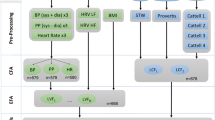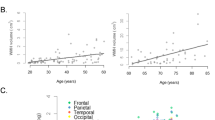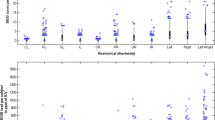Abstract
Changes in neurovascular coupling are associated with both Alzheimer’s disease and vascular dementia in later life, but this may be confounded by cerebrovascular risk. We hypothesized that hemodynamic latency would be associated with reduced cognitive functioning across the lifespan, holding constant demographic and cerebrovascular risk. In 387 adults aged 18–85 (mean = 48.82), dynamic causal modeling was used to estimate the hemodynamic response function in the left and right V1 and V3-ventral regions of the visual cortex in response to a simple checkerboard block design stimulus with minimal cognitive demands. The hemodynamic latency (transit time) in the visual cortex was used to predict general cognitive ability (Full-Scale IQ), controlling for demographic variables (age, race, education, socioeconomic status) and cerebrovascular risk factors (hypertension, alcohol use, smoking, high cholesterol, BMI, type 2 diabetes, cardiac disorders). Increased hemodynamic latency in the visual cortex predicted reduced cognitive function (p < 0.05), holding constant demographic and cerebrovascular risk. Increased alcohol use was associated with reduced overall cognitive function (Full Scale IQ 2.8 pts, p < 0.05), while cardiac disorders (Full Scale IQ 3.3 IQ pts; p < 0.05), high cholesterol (Full Scale IQ 3.9 pts; p < 0.05), and years of education (2 IQ pts/year; p < 0.001) were associated with higher general cognitive ability. Increased hemodynamic latency was associated with reduced executive functioning (p < 0.05) as well as reductions in verbal concept formation (p < 0.05) and the ability to synthesize and analyze abstract visual information (p < 0.01). Hemodynamic latency is associated with reduced cognitive ability across the lifespan, independently of other demographic and cerebrovascular risk factors. Vascular health may predict cognitive ability long before the onset of dementias.





Similar content being viewed by others
Data availability
The data that support the findings of this study are openly available in Collaborative Informatics and Neuroimaging Suite (COINS) at https://coins.trendscenter.org, reference number NKI-RS.
References
Ances BM, Liang CL, Leontiev O, Perthen JE, Fleisher AS, Lansing AE, Buxton RB (2009) Effects of aging on cerebral blood flow, oxygen metabolism, and blood oxygenation level dependent responses to visual stimulation. Hum Brain Mapp 30(4):1120–1132
Anstey KJ, Lipnicki DM, Low L-F (2008) Cholesterol as a risk factor for dementia and cognitive decline: a systematic review of prospective studies with meta-analysis. Am J Geriatr Psychiatry 16(5):343–354
Anttila T, Helkala E-L, Viitanen M, Kåreholt I, Fratiglioni L, Winblad B, Soininen H, Tuomilehto J, Nissinen A, Kivipelto M (2004) Alcohol drinking in middle age and subsequent risk of mild cognitive impairment and dementia in old age: a prospective population based study. BMJ 329(7465):539
Bahrani AA, Powell DK, Yu G, Johnson ES, Jicha GA, Smith CD (2017) White matter hyperintensity associations with cerebral blood flow in elderly subjects stratified by cerebrovascular risk. J Stroke Cerebrov Dis 26(4):779–786
Birkenhäger WH, Forette F, Seux M-L, Wang J-G, Staessen JA (2001) Blood pressure, cognitive functions, and prevention of dementias in older patients with hypertension. Arch Intern Med 161(2):152–156
Braak H, Alafuzoff I, Arzberger T, Kretzschmar H, Del Tredici K (2006) Staging of Alzheimer disease-associated neurofibrillary pathology using paraffin sections and immunocytochemistry. Acta Neuropathol 112(4):389–404
Breteler MM (2000) Vascular risk factors for Alzheimer’s disease: an epidemiologic perspective. Neurobiol Aging 21(2):153–160
Buckner RL, Snyder AZ, Sanders AL, Raichle ME, Morris JC (2000) Functional brain imaging of young, nondemented, and demented older adults. J Cognit Neurosci 12(Supplement 2):24–34
Buxton RB, Wong EC, Frank LR (1998) Dynamics of blood flow and oxygenation changes during brain activation: the balloon model. Magn Reson Med 39(6):855–864
Buxton RB, Uludağ K, Dubowitz DJ, Liu TT (2004) Modeling the hemodynamic response to brain activation. Neuroimage 23:S220–S233
Chang C-CH, Zhao Y, Lee C-W, Ganguli M (2012) Smoking, death, and Alzheimer’s disease: a case of competing risks. Alzheimer Dis Assoc Disord 26(4):300
Claus JJ, Breteler M, Hasan D, Krenning E, Bots M, Grobbee D, Van Swieten J, Van Harskamp F, Hofman A (1998) Regional cerebral blood flow and cerebrovascular risk factors in the elderly population. Neurobiol Aging 19(1):57–64
de la Torre JC (2012) Cerebral hemodynamics and vascular risk factors: setting the stage for Alzheimer's disease. Journal of Alzheimer's Disease 32(3):553–567
Dolan H, Crain B, Troncoso J, Resnick SM, Zonderman AB, Obrien RJ (2010) Atherosclerosis, dementia, and Alzheimer disease in the Baltimore Longitudinal Study of Aging cohort. Ann Neurol 68(2):231–240
Dumoulin SO, Wandell BA (2008) Population receptive field estimates in human visual cortex. Neuroimage 39(2):647–660
Elias MF, Wolf PA, D'Agostino RB, Cobb J, White LR (1993) Untreated blood pressure level is inversely related to cognitive functioning: the Framingham Study. Am J Epidemiol 138(6):353–364
Evans R, Emsley C, Gao S, Sahota A, Hall K, Farlow M, Hendrie H (2000) Serum cholesterol, APOE genotype, and the risk of Alzheimer’s disease: a population-based study of African Americans. Neurology 54(1):240–240
Evans R, Hui S, Perkins A, Lahiri D, Poirier J, Farlow M (2004) Cholesterol and APOE genotype interact to influence Alzheimer disease progression. Neurology 62(10):1869–1871
Friston KJ, Mechelli A, Turner R, Price CJ (2000) Nonlinear responses in fMRI: the Balloon model, Volterra kernels, and other hemodynamics. NeuroImage 12(4):466–477
Friston KJ, Harrison L, Penny W (2003) Dynamic causal modelling. Neuroimage 19(4):1273–1302
Friston K, Preller KH, Mathys C, Cagnan H, Heinzle J, Razi A, Zeidman P (2017) Dynamic causal modelling revisited. Neuroimage. https://doi.org/10.1016/j.neuroimage.2017.02.045
Girouard H, Iadecola C (2006) Neurovascular coupling in the normal brain and in hypertension, stroke, and Alzheimer disease. J Appl Physiol 100(1):328–335
Gröschel K, Terborg C, Schnaudigel S, Ringer T, Riecker A, Witte O, Kastrup A (2007) Effects of physiological aging and cerebrovascular risk factors on the hemodynamic response to brain activation: a functional transcranial Doppler study. Eur J Neurol 14(2):125–131
Hamzei F, Knab R, Weiller C, Röther J (2003) The influence of extra-and intracranial artery disease on the BOLD signal in FMRI. Neuroimage 20(2):1393–1399
Heatherton TF, Kozlowski LT, Frecker RC, Fagerström K-O (1991) The Fagerström test for nicotine dependence: a revision of the Fagerstrom Tolerance Questionnaire. Br J Addict 86(9):1119–1127
Heinzle J, Koopmans PJ, den Ouden HE, Raman S, Stephan KE (2016) A hemodynamic model for layered BOLD signals. Neuroimage 125:556–570
Hirao K, Ohnishi T, Hirata Y, Yamashita F, Mori T, Moriguchi Y, Matsuda H, Nemoto K, Imabayashi E, Yamada M (2005) The prediction of rapid conversion to Alzheimer's disease in mild cognitive impairment using regional cerebral blood flow SPECT. Neuroimage 28(4):1014–1021
Jafarian A, Litvak V, Cagnan H, Friston KJ, Zeidman P (2019) Neurovascular coupling: insights from multi-modal dynamic causal modelling of fMRI and MEG. arXiv:1903.07478
Jarvik GP, Wijsman EM, Kukull WA, Schellenberg G, Yu C, Larson EB (1995) Interactions of apolipoprotein E genotype, total cholesterol level, age, and sex in prediction of Alzheimer's disease. A case-control study. Neurology 45(6):1092–1096
Johnston SC, Hauser SL (2010) The challenge of publishing newsworthy epidemiology. Ann Neurol 68(2):A8–A10
Kuźma E, Lourida I, Moore SF, Levine DA, Ukoumunne OC, Llewellyn DJ (2018) Stroke and dementia risk: a systematic review and meta-analysis. Alzheimer's Dement. https://doi.org/10.1016/j.jalz.2018.06.3061
Lang PJ, Bradley MM, Fitzsimmons JR, Cuthbert BN, Scott JD, Moulder B, Nangia V (1998) Emotional arousal and activation of the visual cortex: an fMRI analysis. Psychophysiology 35(2):199–210
Launer LJ, Masaki K, Petrovitch H, Foley D, Havlik RJ (1995) The association between midlife blood pressure levels and late-life cognitive function: the Honolulu-Asia Aging Study. JAMA 274(23):1846–1851
Leuba G, Kraftsik R (1994) Changes in volume, surface estimate, three-dimensional shape and total number of neurons of the human primary visual cortex from midgestation until old age. Anat Embryol 190(4):351–366
McGuinness B, Todd S, Passmore P, Bullock R (2009) Blood pressure lowering in patients without prior cerebrovascular disease for prevention of cognitive impairment and dementia. Cochrane Database Syst Rev. https://doi.org/10.1002/14651858.CD004034.pub3
Mentis MJ, Horwitz B, Grady CL, Alexander GE, VanMeter JW, Maisog JM, Pietrini P, Schapiro MB, Rapoport SI (1996) Visual cortical dysfunction in Alzheimer's disease evaluated with a temporally graded" stress test" during PET. Am J Psychiatry. 153:23–40
Muldoon MF, Ryan CM, Matthews KA, Manuck SB (1997) Serum cholesterol and intellectual performance. Psychosom Med 59(4):382–387
Nobili F, Rodriguez G, Marenco S, De Carli F, Gambaro M, Castello C, Pontremoli R, Rosadini G (1993) Regional cerebral blood flow in chronic hypertension. A correlative study. Stroke 24(8):1148–1153
Nooner KB, Colcombe SJ, Tobe RH, Mennes M, Benedict MM, Moreno AL, Panek LJ, Brown S, Zavitz ST, Li Q (2012) The NKI-Rockland sample: a model for accelerating the pace of discovery science in psychiatry. Front Neurosci. https://doi.org/10.3389/fnins.2012.0015
Notkola I-L, Sulkava R, Pekkanen J, Erkinjuntti T, Ehnholm C, Kivinen P, Tuomilehto J, Nissinen A (1998) Serum total cholesterol, apolipoprotein E FC12 e4 allele, and Alzheimer’s disease. Neuroepidemiology 17(1):14–20
Novak V (2012) Cognition and hemodynamics. Curr Cardiov Risk Rep 6(5):380–396
Novak V, Hajjar I (2010) The relationship between blood pressure and cognitive function. Nat Rev Cardiol 7(12):686
Østergaard L, Aamand R, Gutiérrez-Jiménez E, Ho Y-CL, Blicher JU, Madsen SM, Nagenthiraja K, Dalby RB, Drasbek KR, Møller A (2013) The capillary dysfunction hypothesis of Alzheimer's disease. Neurobiol Aging 34(4):1018–1031
Penny WD, Friston KJ, Ashburner JT, Kiebel SJ, Nichols TE (2011) Statistical parametric mapping: the analysis of functional brain images. Elsevier, Amsterdam
Pineiro R, Pendlebury S, Johansen-Berg H, Matthews P (2002) Altered hemodynamic responses in patients after subcortical stroke measured by functional MRI. Stroke 33(1):103–109
Riecker A, Grodd W, Klose U, Schulz JB, Gröschel K, Erb M, Ackermann H, Kastrup A (2003) Relation between regional functional MRI activation and vascular reactivity to carbon dioxide during normal aging. J Cereb Blood Flow Metab 23(5):565–573
Rigoux L, Stephan KE, Friston KJ, Daunizeau J (2014) Bayesian model selection for group studies—revisited. Neuroimage 84:971–985
Robbins MA, Elias MF, Elias PK, Budge MM (2005) Blood pressure and cognitive function in an African-American and a Caucasian-American sample: the Maine-Syracuse Study. Psychosom Med 67(5):707–714
Rytsar R, Fornari E, Frackowiak RS, Ghika JA, Knyazeva MG (2011) Inhibition in early Alzheimer's disease: an fMRI-based study of effective connectivity. Neuroimage 57(3):1131–1139
Schmidt M (1996) Rey auditory verbal learning test: a handbook. Western Psychological Services, Los Angeles
Smith AT, Greenlee MW, Singh KD, Kraemer FM, Hennig J (1998) The processing of first-and second-order motion in human visual cortex assessed by functional magnetic resonance imaging (fMRI). J Neurosci 18(10):3816–3830
Solomon A, Kivipelto M, Wolozin B, Zhou J, Whitmer RA (2009) Midlife serum cholesterol and increased risk of Alzheimer’s and vascular dementia three decades later. Dement Geriatr Cogn Disord 28(1):75–80
Sotero RC, Trujillo-Barreto NJ, Jiménez JC, Carbonell F, Rodríguez-Rojas R (2009) Identification and comparison of stochastic metabolic/hemodynamic models (sMHM) for the generation of the BOLD signal. J Comput Neurosci 26(2):251–269
Stano JF (2004) Wechsler abbreviated scale of intelligence. Rehab Counsel Bull 48(1):56
Stephan KE, Penny WD, Daunizeau J, Moran RJ, Friston KJ (2009) Bayesian model selection for group studies. Neuroimage 46(4):1004–1017
Sue Baron I (2004) Delis-Kaplan executive function system. Child Neuropsychol 10(2):147–152
Trammell JP, MacRae PG, Davis G, Bergstedt D, Anderson AE (2017) The relationship of cognitive performance and the theta-alpha power ratio is age-dependent: an EEG study of short term memory and reasoning during task and resting-state in healthy young and old adults. Front Aging Neurosci 9:364
Wan X, Riera J, Iwata K, Takahashi M, Wakabayashi T, Kawashima R (2006) The neural basis of the hemodynamic response nonlinearity in human primary visual cortex: Implications for neurovascular coupling mechanism. Neuroimage 32(2):616–625
Wang L, Mruczek RE, Arcaro MJ, Kastner S (2014) Probabilistic maps of visual topography in human cortex. Cereb Cortex 25(10):3911–3931
West KL, Zuppichini MD, Turner MP, Sivakolundu DK, Zhao Y, Abdelkarim D, Spence JS, Rypma B (2019) BOLD hemodynamic response function changes significantly with healthy aging. NeuroImage 188:198–207
Wierenga CE, Dev SI, Shin DD, Clark LR, Bangen KJ, Jak AJ, Rissman RA, Liu TT, Salmon DP, Bondi MW (2012) Effect of mild cognitive impairment and APOE genotype on resting cerebral blood flow and its association with cognition. J Cereb Blood Flow Metab 32(8):1589–1599
Wierenga CE, Hays CC, Zlatar ZZ (2014) Cerebral blood flow measured by arterial spin labeling MRI as a preclinical marker of Alzheimer's disease. J Alzheimer's Dis 42(s4):S411–S419
Wu L-T, McNeely J, Subramaniam GA, Sharma G, VanVeldhuisen P, Schwartz RP (2016) Design of the NIDA clinical trials network validation study of tobacco, alcohol, prescription medications, and substance use/misuse (TAPS) tool. Contemp Clin Trials 50:90–97
Zeidman P, Jafarian A, Corbin N, Seghier ML, Razi A, Price CJ, Friston KJ (2019) "A tutorial on group effective connectivity analysis, part 1: first level analysis with DCM for fMRI. NeuroImage. https://doi.org/10.1016/j.neuroimage.2019.06.031
Zhou J, Yu J-T, Wang H-F, Meng X-F, Tan C-C, Wang J, Wang C, Tan L (2015) Association between stroke and Alzheimer's disease: systematic review and meta-analysis. J Alzheimer Dis 43(2):479–489
Author information
Authors and Affiliations
Corresponding author
Ethics declarations
Conflict of interest
The Authors have declared that there are no conflicts of interest in relation to the subject of this study. The dataset was originally collected at the Nathan Kline Institute (NKI). All NKI subjects provided written informed consent after receiving a complete description of the study; this study was approved by the Institutional Review Board and adheres to US Federal Policy for the Protection of Human Subjects. Institutional Review Board Approval was obtained for this project at the Nathan Kline Institute (Phase I #226781 and Phase II #239708) and at Montclair State University (Phase I #000983A and Phase II #000983B). Funding: This work was supported by the Burroughs Wellcome Fund and the National Institutes of Health (NIH) – (National Institute of Mental Health UL1DE019580, R01MH101478, PL1MH083271 to RB, R03MH106922 to RB and AA; by the National Institute on Aging (NIA) K25AG051782 to AA, and by a Research Supplement to Promote Diversity in Health-Related Research Award U01 AG052564-01 from NIA to MDS. Ariana E Anderson, Ph.D., holds a Career Award at the Scientific Interface from BWF. PL is supported by grants R01NS075930 and U01 NS088312 from the National Institute of Neurological Disorders and Stroke, and by the Carmen and Louis Warschaw Family Chair in Neurology, and by the Lippman Family Foundation.
Additional information
Publisher's Note
Springer Nature remains neutral with regard to jurisdictional claims in published maps and institutional affiliations.
Electronic supplementary material
Below is the link to the electronic supplementary material.
Rights and permissions
About this article
Cite this article
Anderson, A.E., Diaz-Santos, M., Frei, S. et al. Hemodynamic latency is associated with reduced intelligence across the lifespan: an fMRI DCM study of aging, cerebrovascular integrity, and cognitive ability. Brain Struct Funct 225, 1705–1717 (2020). https://doi.org/10.1007/s00429-020-02083-w
Received:
Accepted:
Published:
Issue Date:
DOI: https://doi.org/10.1007/s00429-020-02083-w




